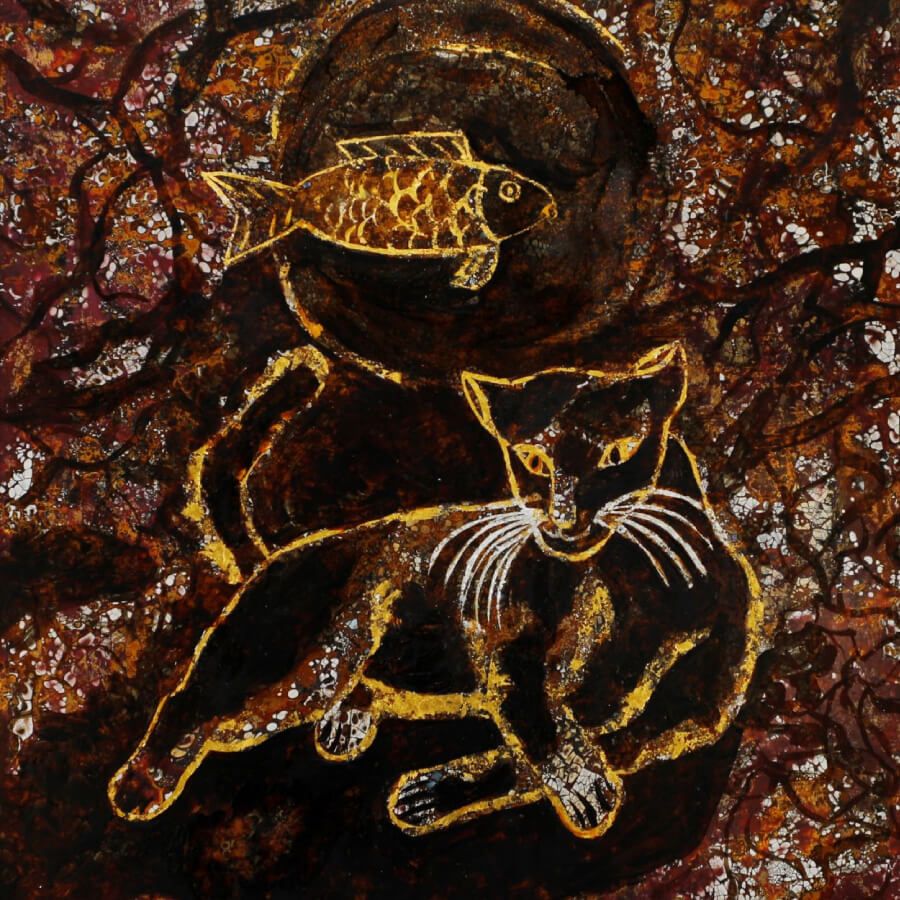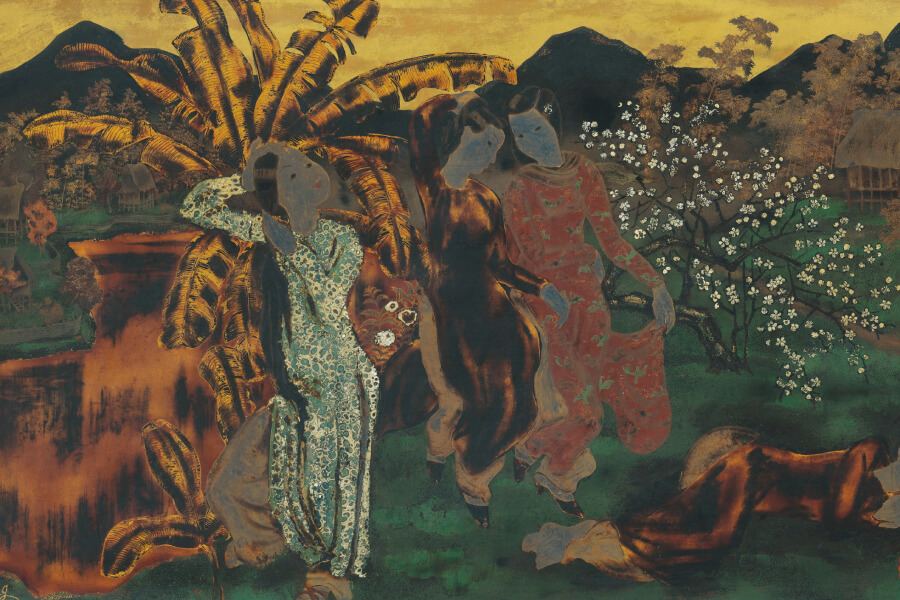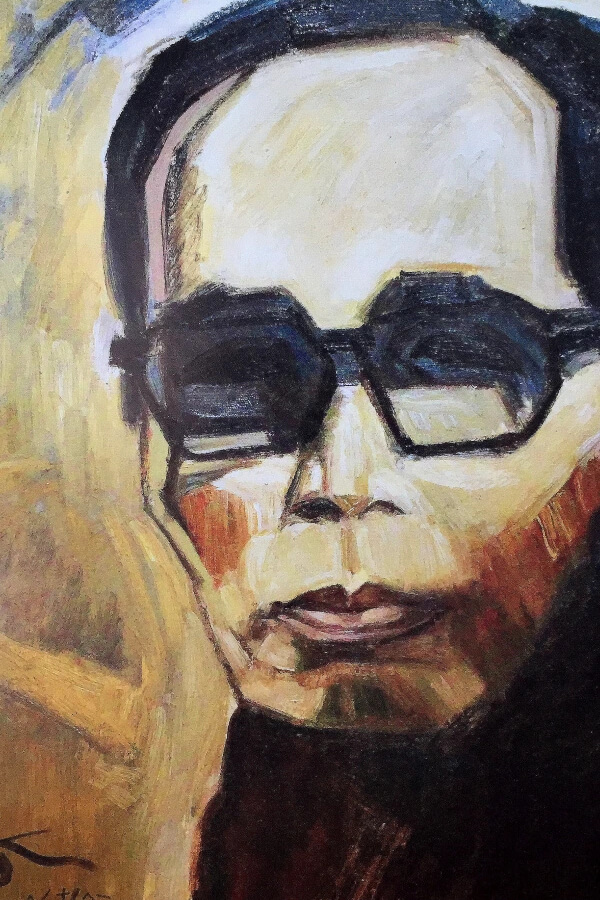Biography of Nguyen Tien Chung
Nguyen Tien Chung, was born 8 August, in Uoc Le village, Tan Uoc commune, Thanh Oai district, Ha Noi, Viet Nam. He was a graduate of class XI (1936 – 1941) of the Indochina Fine Arts College and he became a teacher at this college in 1946.
Over the period between 1947 and 1953, he joined the Viet Minh movement in Hanoi. He was a Member of the Executive Committee of the Vietnam Fatherland Front in Hanoi (1954), teacher at Vietnam University of Fine Arts (1955 – 1964), Member of the Executive Committee of Vietnam Fine Arts Association (Phase I, 1957 – 1968), Member of the Arts Council of Hanoi Fine Arts Association (1966 – 1976).
Nguyen Tien Chung ranked 398th in the list of famous painters.
He passed away on March 5th, 1976 at the age of 62.
Nguyen Tien Chung ‘s Career
Nguyen Tien Chung has been playing installation art since the 1950s-1960s while this type was only really introduced to Vietnam at the end of the 20th century. No matter what material he composed on, he always kept in mind that “Our eyes are far away to see the world, but our feet must stand on the land of Vietnam. Never lose roots, learn the world’s art to raise our understanding.” Because of this, the artist’s works are always aimed at ethnic elements. His works in the period of contemporary artistic influence such as Meo and Mouse, Buffalo, Nguyen Tien Chung always seek and breathe into the paintings the fresh national soul in addition to the new style of writing.
He often composes about Vietnamese farmers, rural areas, young women, soldiers, and workers with a deep Asian style. He memorized all the faces of old women, babies, and village women to the countryside, the corner of the yard, the granary, the scenes of buffalo herding, plowing, and reaping… The love of the village sparkled in his charming drawings. The oil painting “Chăn trâu” in 1975 depicts a child playing a kite with a gentle buffalo in the evening light dyed in red, with the same colors as a folk painting. The distinctive woodcut “Chợ Nông” in 1956, painted in Phu Tho, vividly depicts the scene of a rural market with dresses, square towels, and conical hats, with a sense of rejoicing to see a banyan tree, a communal house. Lines and colors are not noisy and boisterous, but graceful and graceful like a six-eighth poem. The soul of the countryside flutters on the surface of the do paper, the ivory background is lovely. Farmers are playful dancers, harvesting crops. Harmonious yellow-brown color, full of warmth. Silky golden silk is shiny, smooth and surprisingly clear. The 1963 lacquer painting “Đập lúa” depicts a busy day and season, working at night under the shining three-string lights, three powerful characters occupying the entire surface of the picture, the lines are large, strong, and rustic.

Nguyen Tien Chung is a multi-talented artist who paints a variety of materials from gouache, grape ink to oil paint, lacquer, silk, woodcarving… Nguyen Tien Chung’s silk paintings are boldly oriental, always promoting the strokes. Traditional silk with the unique beauty of shiny silk, rich in poetry. Lacquer paintings have strong and distinctive features. Oil painting with its own style, light colors and elegant points. His woodcuts are created according to the traditional concept of shaping, using delicate strokes with soft patches of color and gentle dithering. Gouache paintings are shown in clarity on a dark or light background, the ability to express emotions is shown in all shades… It can be seen that, regardless of the material, he also exploits the maximum strengths of lines, combined with light, subtle color patches.
With many unique and emotional compositions about the landscape, people and homeland, the works of painter Nguyen Tien Chung creatively absorb national traditions, bringing high artistic value. He has passed on to many later generations of painters valuable professional experience, his work has had a great influence in the art world.
Painter Nguyen Tien Chung passed away in 1976 due to a serious illness. He lived through the years of hardship, poverty, but joy and happiness.
Two Controversial paintings of Nguyen Tien Chung
He was in the same class as the painters Nguyen Van Ty, Hoang Tich Chu, Bui Trang Chuoc. Many artists retold the story of controversial paintings to remember a marked period of Vietnamese Fine Arts in the past.
From 1963 to 1964, Nguyen Tien Chung worked on the painting Threshing Rice At Night. Despite being a small lacquer painting, it represented a dramatic shift to his artistic concept. He usually conducted in-depth research on rural life including even small details such as cow barns, kitchen corners and baskets. Before painting, he adjusted the colors and the images; unlike other artists such as Nguyen Sang and Bui Xuan Phai, he did not paint continuously. Especially, he was fascinated by harvest time so it became the theme of many of his paintings. As regards Threshing Rice At Night, its layout included only three characters and it emphasized on the middle person who threw a sheaf of rice to the millstone. The woman on the right shouldered another sheaf of rice. The woman on the left tried to put her sheaf of rice on the head and she prepared to throw it to the millstone. An array of light was generated to show a contrast with the other one from the women. Thanks to his arrangement, the women had stocky builds in harmony with the working landscape that made his painting vivid, spontaneous and cozy.

Nevertheless, when the painting was on exhibition, an authority said that: “The farmers in the painting are hefty with big hands and big legs that worsened the image of labors under Socialism”. There were strong arguments for and against Nguyen Tien Chung among the artists. Some people supposed that the painting was a creative work following “Fauvism” (a French style of painting in which people and objects are represented in a spontaneous and strong way) and it cogently expressed the characteristics of Vietnamese farmers. Others thought that Nguyen Tien Chung worsened the image of farmers so he was guilty of formalism.
After that, although the painting was on exhibition in the Soviet Union, it was not displayed later. Nguyen Tien Chung’s concept was rectified in the reviews of artistic experiences. However, Nguyen Tien Chung still believed that the painter had to be professional and enthusiastic to deal with the theme of labor and revolution. Indiscriminate paintings could lead to negative consequences for the art. He thought that famers and workers fed the society with their labors, hence, it was necessary to depict them in good health, not only simple but strong as well.
In 1968, the painting Harvest (Nguyen Tien Chung’s largest painting executed after the revolution) was displayed on the national fine arts exhibition. It was difficult for him to work on this painting due to limited facilities (he could not hire anyone as the employment was considered as the exploitation). The painting was almost a “successful synthesis” of working landscape during the harvest. However, it was also criticized for painting farmers like the painting Threshing Rice At Night. Thus, Nguyen Tien Chung just won the third prize for the painting and it was not bought by the museum. After that, he asked his daughter to throw it to the pond but at the same time, Duc Minh visited him and changed his wooden furniture for the painting, meanwhile, bought another painting. In 1976, Nguyen Tien Chung was sick and his wife had to sell the wooden furniture for 2 thousand VND. Duc Minh’s collection also disappeared after his death. The painting Harvest belonged to the collector Danh An afterwards. Fortunately, this priceless artwork did not get lost.
Nguyen Tien Chung‘s Highlighted Artworks
His outstanding artworks:
• Good Harvest (Silk paiting,1958)
• Nhong Market (colored woodcut, 1958)
• Sai Gon Landscape (Colored woodcut, 1970)
• Female militants share experiences in shooting bombers (oil painting, 1971)…



